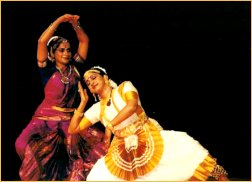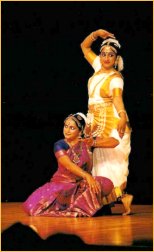 |
 |
Jugalbandhi in St.Louis by Anu Chellappa e-mail: ac7196@sbc.com |
| July
5, 2003
“Abhinaya”, St.Louis, a non-profit organization devoted to promoting Indian classical dances presented a jugalbandi on 29th June, at the Chesterfield YMCA Theater, St.Louis, Missouri, USA. Smitha Rajan, of Nritya Kshetra, St.Louis danced in Mohiniyattam style and Indira Kadambi, of Ambalam, Madras, danced in Bharatanatyam style. T V Ramprasadh was the singer, Ramesh Babu played the mridangam and maddalam, and Ravichandra Kulur played the flute. The first item was a Ganesha Vandanam, with Tulsidas’ bhajan "Gaayiye Ganapathi jagavandana…." sung in Valaji raga. Both the dancers made a beautiful entry to the stage - Indira Kadambi with sprightly, energetic adavus so typical of Bharatanatyam, and Smitha Rajan, with flowing, graceful steps so characteristic of Mohiniyattam. In the background were swaras in Valaji, sung by TVR. The notes from Ravichandra's flute seemed to flutter around like butterflies. The dancers described Lord Ganesha, with short episodes, and offered their prayers to Him. The second item was a solo Bharatanatyam piece by Indira – “Ananda Natanam aduvar” in Poorvi Kalyani. It was a pleasant item, and Indira made full use of the stage, executing her adavus neatly and completely. The third item was a “slokam” (traditionally the sixth item in the Mohiniyattam repertoire) by Smitha. The slokam was a composition of Adi Shankara, describing the eight moods of Goddess Parvathi. It started off with a very serene rendering of “Om…” by TVR, transporting the rasika to a meditative mood. Smitha took off from there, with her description of Parvathi and her eight moods: Sringara, jugupsa, bheeta, veera, vismaya, rosha, hasya, karuna…. By the time the piece ended, I had the feeling that I had been led into a temple and witnessed the Goddess of the temple, and felt deeply prayerful and silent. The fourth piece was the grand big item for the day – the Dashaavataram, composed by Udumalaipettai Narayana Kavi, in raga malika and tala malika (beginning: “paarkadal alai mele, in Shanmukhapriya). Both the dancers had choreographed this very well, so that although there were two dancers dancing in two different styles on the stage, the piece as a whole was cohesive and woven beautifully. Indira’s portrayal of Vamana was very good, while Smitha’s portrayal of Narasimha brought out the roudra very well. Both their description of the birth of Sri Krishna, His being carried over by Vasudeva, and His pranks at Ayarpadi, were all very enjoyable. The Gitopadesham was very poignant. Smitha’s steps for the swaras immediately following this avataram were especially catchy – the dancer and the mridangam player seemed to be enjoying that bit! |
| Smitha
and Indira’s portrayal for Sri Rama avataram was also excellent, with both
of them quickly changing roles – Sita, Rama, Ravana (in disguise as the
beggar, and later as the king).
Finally, the
description of a decadent people, full of evil, heralding the arrival of
Kalki, was very real. The piece concluded with TVR singing “Ranganatha”
10 times, each in a different raga, while the dancers posed and froze into
each avatara roopa.
|
 |
| After
a short break, the program resumed with an ashtapadi by Indira (raga: Shudda
Sarang). This was about Radha describing to her sakhi her first union with
Krishna, and how shy and how happy she felt! Most of the first half was
done with Indira sitting down comfortably. She expressed nicely the various
levels of shyness that Radha felt, and it was a pleasure to watch, (in
these days when feelings like coy, demure, timid or bashful seem to be
so rare!). Radha then asks her sakhi to go and bring back her Krishna.
Next we had Smitha as the sakhi, bringing back her message from Krishna! This padam was a composition of her grandmother Kalamandalam Kalyanikuttiamma, in Kapi and Shankarabharanam. It was a very beautiful thought, when the sakhi comes back and says: “ I saw him! I saw him…I touched the sacred earth where He stood; I gathered the golden dust His feet had sanctified and I showered myself with that….”The sakhi cannot stop talking about what she saw, and this was brought out beautifully in the eyes of Smitha – the eyes of someone who had seen the Divine! The sakhi goes on to explain: “He was not angry with me, nor did he mock at me, rather, He turned his kind eyes towards me, and said “Go and tell your friend that her love is safe with me,” Oh my dear friend, are you happy now??” |
| The final piece for the day was the Dhanasri Thillana, a composition of Swati Tirunal. The thillana was preceded with a Hindi verse describing Brindavan. Here both the dancers did a wonderful job – taking us along with them into the beautiful, divine garden – full of fresh plants and creepers, flowers, bees, ponds, peacocks……… Then started the thillana. Smitha and Indira alternated, each with a set of adavus, each dancer doing full justice to her style, not for a moment going out of her own style, and yet, blending in and dancing to the same song! There were some steps, which were similar, chosen and performed well, so that they seemed to be in synchronization, and yet, on a closer look, what Indira was doing was distinctive Bharatanatyam adavus, with intricate jathis, while what Smitha was doing was classic Mohiniyattam, with its absolute grace in each and every step or minute movement. |  |
| T
V Ramprasadh sang soulfully, and he was very sensitive to the dancer’s
feelings and movements – his voice being soft and gentle for Mohiniyattam,
whenever necessary, and sharp and quick for the Bharatanatyam adavus. Ramesh
Babu is an experienced mridangam player for dancers, and this was evident
throughout the program. He was totally at ease switching over from mridangam
to maddalam (maddalam for the Mohiniyattam), whenever both dancers were
on stage. Ravichandra on the flute also seemed very experienced and comfortable.
He arrived late that morning, after an overnight flight and a four-hour
halt at Detroit. Credit goes to him that he plunged into “work” as soon
as he arrived at St. Louis.
The evening
concluded with a mangalam, and after that, all the five artistes received
a standing ovation for a well-presented, lovely, memorable program.
|